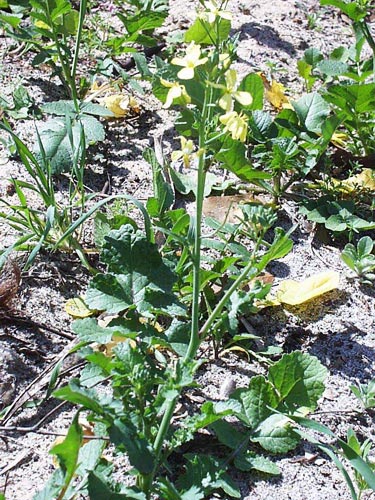Weeds
Brassica juncea (L.) Czern. - Indian Mustard.
Synonims.
Sinapis juncea L.Systematic position.
Family Brassicaceae Burnett (Cruciferae Juss.), genus Brassica L.Biological group.
Spring annual weed.Morphology and biology.
Plant is up to 100 cm tall. Stem is glabrous, branched. Lower leaves are green, lyrate-pinnatifid or more rarely almost entire, petiolate, with rigid sparse hairs along ribs and petioles from below or more rarely glabrous. Stem leaves are glaucous, not amplexicaul, in the middle of the stem their shape is similar to the lower leaves. Upper leaves are oblong-linear, entire, sessile, rarely located on short petioles. Inflorescence is nearer to corymbose, petals are golden yellow, 1.5 times as long as sepals. Fruit is silicle. Silicles are twice as long as petals, slantwise-upward directed, tubercular, with thin subulate beak which is about four times shorter than silicle, middle rib on the valves of silicle is clearly visible. Seeds are globular, dark-brown, or more rarely yellow. This plant flowers in June-July and bears fruits in August-September. Maximum productivity is up to 20,000 seeds. As usual, after ripening seeds don't germinate. Seeds begin to germinate in the spring, after over-wintering, in warm soil, from depths down to 6 cm, and continue until late autumn. In deeper soil layers seeds remain viable for up to 5 years.Distribution.
Species grows in southern regions of the Former Soviet Union, the Caucasus, Western and Eastern Siberia, the Far East, Central Asia. General distribution: Middle Europe, Asia Minor, Iran, Afghanistan, India, Mongolia, China, Japan. This species is of Asiatic origin.Ecology.
It is drought resistant. Brassica juncea often creates thick herbage. This plant strongly exhausts soil, taking a lot of its nutrients.Economic significance.
Brassica juncea infests all spring crops including grain and tilled crops, and vegetable gardens. It grows in large amounts in fallows and sod fields in the southern parts of the Former Soviet Union, sometimes entering the forest zone. This plant is cultivated as an oil crop and for preparation of mustard powder in the south-east of the European part of Russia, in Ukraine, Belorussia and the North Caucasus. Seeds of B. juncea contain 25-30% fatty non-drying oil and glycoside sinigrine; oilcake is used for preparation of mustard powder. Leaves are used for food in salads, they contain up to 150 mg of ascorbic acid. B. juncea is a good bee plant. It is used as green manure and as forage for milk cattle. Control measures include shallow plowing and plowing in autumn, soil harrowing early in spring, which favors weed seed germination, then eradication of seedlings.Reference citations:
Fomina Z.V. 1962. Weed plants of Buryatia and their control measures. Ulan-Ude: Publishing House of Buryatia. 76 p. (In Russian)Keller B.A., ed. 1934. Weed plants of the USSR. V. 3. Leningrad: AN SSSR. 448 p. (In Russian)
Komarov, V.L. & N.A. Bush, eds. 1939. Flora of the USSR. V. 8. Moscow-Leningrad: AN SSSR. 696 p. (In Russian)
Nikitin, V.V. 1983. Weed plants of the USSR flora. Leningrad: Nauka. 454 p. (In Russian)
Ulyanova T.N. 1998. Weed plants in flora of Russia and other CIS countries. St. Petersburg: VIR. 343 p. (In Russian)


